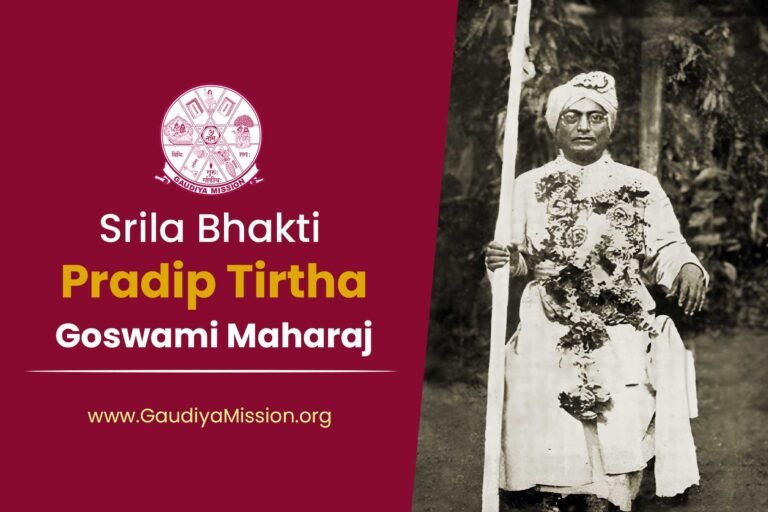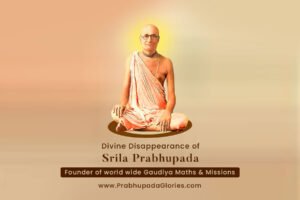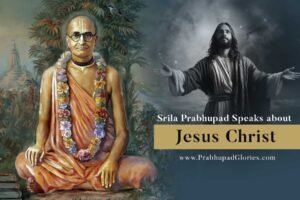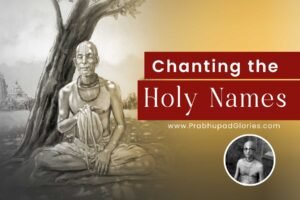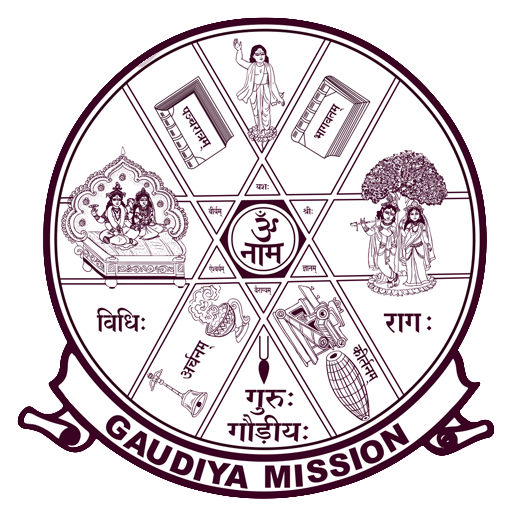Sri Rajanikanta Basu, a government employee from a village in Noakhali District, East Bengal, and his wife Srimati Bidhumukhi became disciples of Srila Bhaktivinoda Thakura after rejecting their jata-gosai guru. At the close of his life, Sri Rajanikanta accepted the dress and vows of a Babaji from Srila Bhaktisiddhanta Sarasvati. Bidhumukhi spent her last days as a widow in Navadvlpa. Sri Jagadisa Basu, born in 1877, was the first of their five sons, the youngest of whom later became the famed Ananta Vasudeva Prabhu.
After graduating from Calcutta University, Jagadisa lived in Calcutta with his wife and worked as a schoolmaster. On 25 March 1910, Gaura-Jayanti visited Mayapur with his friend Sri Vaikunthanatha Ghosal Bhakti Tattva Vacaspati—a court pandita of the maharaja of Tripura and follower of Srila Bhaktivinoda Thakura. There at the Yogapitha, Jagadisa saw Srila Bhaktivinoda Thakura for the first time, lecturing in the presence of Sri Siddhanta Sarasvati and other devotees.
Upon being introduced by Vaikuntha Babu, Jagadisa prostrated and tearfully requested the shelter of Srila Bhaktivinoda, who said, “You are an educated and respectable person. If you accept the responsibility of preaching on Lord Caitanya’s behalf, certainly many people will be attracted to His message.” Asked by Srila Bhaktivinoda Thakura to speak hari-katha, Jagadisa discoursed on brahmacharya, particularly the incomparable current manifestation of brahmacharya in the personage of Sri Siddhanta Sarasvati. Inspired from within, Jagadisa also declared that from this place of atma-nivedena Mahaprabhu’s prophecy that His name would spread all over the world will be fulfilled.
That same afternoon Sri Siddhanta Sarasvati delivered Hari-katha to Jagadisa for several hours and advised him to ask permission from Srila Bhaktivinoda Thakura to meet Srila Gaura Kisora dasa Babaji at Kuliya. Early the next morning Jagadisa went to Kuliya, where he offered dandavat and a watermelon to Babaji Maharaja. Although normally Babaji Maharaja refused anything brought by outsiders, when he understood that Jagadisa was sent by Thakura Bhaktivinoda, he graciously accepted this presentation. After speaking to Jagadisa for some time he told him to chant a selection from Prarthana. Jagadisa sang the kirtana that begins gauranga bolite habe pulaka sarira.
Babaji Maharaja instructed Jagadisa to have full faith in the guru and Vaisnavas, to become as humble as a blade of grass and more tolerant than a tree, to avoid the association of dishonest persons, and to ceaselessly chant the Lord’s holy names. When Jagadisa said that he had not yet been initiated, Srila Babaji Maharaja posited that since Mayapur is the place of self-surrender and there Jagadisa had already surrendered to Srila Bhaktivinoda, in what other way would he obtain the shelter of a guru? “Go!” he told Jagadisa. “The Thakura is waiting for you.” He then blessed Jagadisa to take sannyasa and preach the name of Mahaprabhu throughout the planet, although at that time there was no indication of either sannyasa in Gaudiya Vaisnavism or worldwide preaching. Jagadisa then touched Srila Babaji Maharaja’s lotus feet—although usually whoever dared try to do so was angrily forbidden by Babaji Maharaja with a promise of destruction.
Following Srila Babaji Maharaja’s advice, Jagadisa returned to Mayapur. At midday on the fifth day after Gaura-Jayanti, having shaved his head and bathed in the Ganga, he and three other devotees were given kama-gayatri and kama-bija mantras by Srila Bhaktivinoda Thakura at his cottage in Godruma. Later Jagadisa relished his guru’s prasada remnants. That same afternoon, the Thakura read from Siksastaka and illuminated it for the devotees, then asked Sri Krsnadasa Babaji to recite from Sanatana-siksa, on which he interspersed comments.
Jagadisa spent much of the following summer at Svananda-sukhada-kunja serving Srila Bhaktivinoda Thakura, on whose order he and Sri Krsnadasa Babaji performed sankirtana every morning all around Godruma, chanting the first song (beginning nadiya-godrume nityananda Mahajan) of Srila Bhaktivinoda Thakura’s “Nagara-kirtan” and preaching to local inhabitants. Every afternoon from about one o’clock to four there was the recitation of Sri Caitanya-caritamrta, followed by kirtana of sri-krsna-caitanya prabhu-nityananda jayadvaita sri- gadadhara srivasadi-gaura-bhakta-vrnda, during which Srila Bhaktivinoda Thakura would dance and gyrate in transcendental bliss. Jagadisa noted that Srila Bhaktivinoda Thakura never allowed ordinary worldly topics to be discussed at Svananda-sukhada-kunja, immediately prohibiting anyone who started speaking such, stressing repeatedly that the dharma for Kali-yuga is harinama. On his occasional visits to Godruma, Sri Siddhanta Sarasvati enthralled Jagadisa by effusively speaking to him on multifarious devotional themes.
Srila Bhaktivinoda Thakura directed Jagadisa and other disciples to emulate Sri Siddhanta Sarasvati’s ideal devotional service. He often told Jagadisa that Sri Gaurasundara had sent Sri Siddhanta Sarasvati to this world with two tasks: to introduce daiva-varnasrama-dharma and to propagate the pure chanting of the holy names within Vaisnava society by establishing a sodality of pure devotees. Srila Bhaktivinoda Thakura often read to Jagadisa his own teachings on varnasrama as detailed in his Caitanya-siksamrta, but Jagadisa could not fathom what it all meant until Sri Siddhanta Sarasvati later inaugurated his preaching mission and practically implemented those instructions.
One day Srila Bhaktivinoda Thakura sent Jagadisa Prabhu and Sri Krsnadasa Babaji to Kuliya for darsana of Srila Gaura Kisora dasa Babaji. Babaji Maharaja was pleased to learn that Jagadisa had been initiated by Srila Bhaktivinoda Thakura, and directed him to also regularly associate with and serve Sri Siddhanta Sarasvati, whom Babaji Maharaja considered and referred to as his guru. As did Srila Bhaktivinoda Thakura, Babaji Maharaja praised Sri Siddhanta Sarasvati, particularly for his strictness in giving up the asat-sanga of pseudo-Vaisnavas and others.
When Srila Bhaktivinoda Thakura returned to Calcutta, Jagadisa Prabhu accompanied him. After some days the Thakura ordered Sri Siddhanta Sarasvati to perform upanayana-sarhskara and give further mantras to Jagadisa and two of Jagadisa’s former fellow students who also were disciples of Srila Bhaktivinoda. Accordingly, Sri Siddhanta Sarasvati bestowed upon them Brahma-gayatri, guru-mantra, guru-gayatri, Gaura-mantra, Gaurarnga-gayatri, and brahmanas’ threads, employing the rites of Sat-kriya-sara-dlpika. On that day Srila Bhaktivinoda Thakura gave Jagadisa varied directions on varnashrama-dharma and advised him to accept the many more indications on this topic that he would receive from Sri Siddhanta Sarasvati in the future. Srila Bhaktivinoda Thakura repeatedly told Jagadisa to follow Sri Siddhanta Sarasvati, who he said would eventually perform multifarious wonderful activities and guide numerous devotees.
Later Sri Siddhanta Sarasvati gave Jagadisa Prabhu the appellation Bhakti Pradipa in appreciation for his dedication to studying sastra and serving Vaisnavas. And after completing the Bhakti-Sastri examination introduced by Sri Siddhanta Sarasvati, Jagadisa Prabhu earned the title Vidyavinoda Bhakti- Sastri Sampradaya-vaibhavacarya.
After his wife died in 1919 Jagadisa Prabhu left his job, gave up all material engagements, and completely dedicated himself to devotional activities under Srila Bhaktisiddhanta Sarasvail’s guidance. On 1 November 1920 at Sri Caitanya Matha, he was ordained as Srila Bhaktisiddhanta Sarasvati’s first sannyasa disciple, with the name Tridandi Svami Srimad Bhakti Pradipa Tlrtha Maharaja, and on the next day sent to preach in East Bengal. In the following years, Srimad Bhakti Pradipa Tirtha Maharaja preached mostly in East Bengal, Orissa, Calcutta, and the West Bengal districts of Burdwan and Midnapore.
The Express wrote of Tirtha Maharaja’s visit to Patna in April 1926:
Swamiji has sacrificed all mundane pleasure for the propagation of Sri Krsna’s religion of the Srimad-Bhagavatam as revealed to us by Lord Gauranga. In his daily discourses, quite in conformity with the Bhagavata path he is showing his vast erudition in the Vedas, the Upanishads, the Vedanta, and other branches of Hindu religion and philosophy. Coupled with his great learning, his deep bhakti has charmed all who have had the good fortune to hear him once. His life and character truly depict what Sri Krsna Caitanya wanted his followers to be.
Those who are prejudiced against Vaisnavism and who have not sunk deep into the sweet religion of Prema and bhakti, those who have studied Vaisnavism through Vaisnava beggars and vairagis and corrupt practices of the so-called followers of Lord Gauranga, will be profited by seeing and hearing Bhakti Pradipa Maharaja, who will shed a divine luster into their hearts—a luster that will dispel all their doubts and show them who is Gauranga and what is the true Vaisnavism.
Being a staunch Vaisnava himself, the Swamiji has mercilessly attacked those followers of his own sect who have led the lofty religion of Sri Gauranga into filthy degeneration, and in this direction, which is also an end of his mission, he has spared nobody.
Quoted in Harmonist25.47 ( July 1927)
In 1933 Srimat Tirtha Maharaja was sent with Srimad Bon Maharaja and Samvidananda Prabhu to begin the mission in Europe. Among his other activities in the West, he wrote prolifically in English, producing many articles, a biography of Caitanya Mahaprabhu, translations of the Bhagavad-gita, and numerous Vaisnava prayers.
Srimad B. P. Tirtha Maharaja was an erudite and dedicated preacher, sedate, yet also simple and innocent like a child. He was instrumental in attracting many recruits to the Gaudiya Matha, including several who were to become prominent: Sundarananda Prabhu, Bhakti Sudhakara Prabhu, Jadubara Prabhu, Giri Maharaja, and Sagara Maharaja. He gave himself fully to devotees placed under his care, and although he was sometimes fiercely intolerant of substandard behavior, those whom he trained typically remembered him with deep gratitude, recognizing that his firmness and occasional anger reflected his deep concern for their spiritual wellbeing.
Although Srimad Bhakti Pradip Tirtha Maharaja had first been instructed and initiated by Srila Bhaktivinoda Thakura, he always maintained the position of a disciple of Srila Bhaktisiddhanta Sarasvati and was respected as the most senior among them.
PREACHING IN THE WEST:
After joining the maṭha, Śrīla Bhakti Pradīpa Tīrtha Gosvāmī Mahārāja became the headmaster of the Śrī Bhaktivinoda Ṭhākura Institute and also taught there. As the institute expanded and grew famous, staff also increased, giving him the liberty to start writing for Śrīla Prabhupāda. In the maṭha, he would engage various devotees in reciting verses, asking the next devotee to recite a verse beginning with the last letter of the earlier verse recited.
In 1932, Śrīla Prabhupāda desired to spread the message of Śrī Caitanya Mahāprabhu outside of India, so that the Western world would not be bereft of this knowledge. He approached Rabindranāth Tagore to discuss international preaching and where he could send his preachers first. Rabindranāth Tagore, who was initially reluctant at the prospect, after much deliberation concluded, “Only if someone like you goes, some positive impact can be achieved.” Śrīla Prabhupāda asserted, “Yes, I will send someone just like me.”

Initially Guru Mahārāja (then Śrī Hayagrīva Brahmacārī) and Śrī Śrīmad Bhakti Hṛdaya Vana Gosvāmī Mahārāja were shortlisted. Hearing this, the Secretary of the Gauḍīya Maṭha and Śrī Śaradendu Nārāyaṇa Rāya, both said, “Firstly, they are both young. Śrī Hayagrīva Brahmacārī is very handsome and hence some of the western ladies may try to attract him. Secondly, out of our sixty-four maṭhas, half are sustained by the collections done by Śrī Hayagrīva Brahmacārī alone. All those would have to be shut down if he were to go abroad. So it is better not to send him.” Thus Śrīla Bhakti Pradīpa Tīrtha Mahārāja, who was older and qualified, was sent in his stead. It is evident that Śrīla Prabhupāda saw these devotees as non-different from himself.
THE DIVINE COINCIDENCE:
Perceiving Śrīla Bhakti Pradīpa Tīrtha Gosvāmī Mahārāja to be a cultured and educated person, Śrīla Bhakti Vinoda Ṭhākura had requested him to address the assembly during the first Viśva-vaiṣṇava-rāja-sabhā held at Māyāpura. At that time, there was just a thatched hut, with all the Yogapīṭha deities installed. During that address, some prophetic words were uttered by Śrīla Mahārāja (then Jagadīśa Bābū), “From this very place, in the future, the message of Mahāprabhu would be broadcast all over the world.” Preaching in the West was not even conceived of then. Nevertheless, it came to pass in 1932, when he himself went to the West to fulfill that prophecy.

